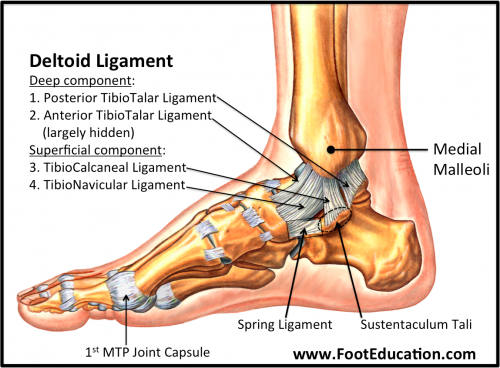Ankle sprains are a very common injury, it is estimated there are roughly 25,000 ankle sprains a day. If you are involved in any sports, it is highly likely that you have or will sustain an ankle injury. 40% of all ankle injuries are ankle sprain and about two thirds of all ankle sprains will have ongoing chronic problems. However, these injuries are typically brushed off as a “minor” alignment. So when, what, and how should these injuries be treated?
Basic Anatomy
Spraining an ankle in basic terms means injuring the ankle ligaments. Ligaments are tissue that connect from one bone to another which stabilize joints during motion. There are three bones that make up the ankle joint: fibula, tibia, and talus (Figure 1). In the ankle joint, there are lateral (outside ankle) collateral ligaments (Figure 2) and medial (inside ankle) collateral ligaments (Figure 3). In addition, there are three ligaments that are “above” the ankle as well. They function together to stabilize the ankle bones during motion.



The Injury
About 85% of all ankle sprains are inversion type injuries, meaning the ankle turns in (Figure 4). The ligaments on the outside of the ankle (lateral collateral ligaments) are being stretched or torn. The severity of the ankle sprain is corelated to the force of the injury. These ligaments sustain small tears or partial tears, complete tear, or avulsion fracture (ligament pulls off the bone). Eversion type injury is rare and occurs when the ankle turns out. Eversion ankle sprain involves the injury of the inside ankle. A high ankle sprain is when the ligaments “above” the ankle are injured. However, ankle sprains are not that simple, they usually involve multiple ligaments, tendons, joints, and bones. The severity if the injury will dedicate your pain, swelling, and inability to bear weight on your ankle.

Following Injury
If immediately after the injury you can walk, run, change direction and/or run, your injury is likely mild. In these instances, wearing an ankle brace, icing, anti-inflammatory medications, and rest may be enough for treatment. However, if you are having difficult walking and or bearing weight on the injured ankle it should be evaluated by a medical professional. The evaluation would be to look for ankle fractures or other injuries.
Treatment
Most people who sustain ankle sprains do not seek treatment. In these mild cases the ankle heals when given some time. In advanced injuries, treatment can vary depending on the ligaments injured and the severity of the injury. In general, if there is no instability of the ankle after injury, this can be treated appropriately in an immobilization device such as a CAM boot for several weeks, physical therapy, icing and anti-inflammatory medications. If there is instability of the ankle joint, surgical fixation will possibly be recommended. Advanced imaging such as an MRI will also be obtained to evaluate the ligaments, cartilage, tendons, and bones.
My Typical Stable Ankle Sprain Treatment
- 2-4 weeks in CAM Boot
- RICE (Rest, Ice, Compression and Elevate)
- Active non-weightbearing exercises
- Transition to ankle brace and supportive shoes
- Weightbearing exercises
- Return to activity or sport once you can hop in place on the injured ankle and change direction without any symptoms.
Surgery
Surgery is indicated for instability of the ankle whether acute or chronic, however most cases have chronic ankle instability. Along with the repair of the ligament involved, sometimes correction of the foot/ankle alignment is required to protect the integrity of repair. In “simple” lateral ankle ligament instability, repair can be performed with sutures, bone anchors with sutures or synthetic ligament. In “complex” lateral ankle ligament instability, repair may be attained by tendon transfer, alignment correction, bone anchors with suture, synthetic ligament etc.
Surgery also may require a “clean up” procedure of the ankle joint and/or repair of any damage to the cartilage or nearby tendons.
Return to Activity
Varies on procedures performed, complexity of the procedures and patient’s activity level. Typically, patient may be non-weightbearing for 2-4 weeks followed by protected weightbearing for 2 weeks and physical therapy. Once patient can tolerate hopping on the surgical repaired ankle and change direction without symptoms they can return to activity.
Until next time…
Dr. P
Book An Appointment Today!
Call (281) 501-0018
Visit Our Website: www.epicfootandankle.com
The information is provided for your assistance only; this information does not provide medical advice. You should never diagnose or treat yourself for a medical condition based on the information provided herein, and the information is not provided for that purpose. Likewise, you should never determine that treatment is unnecessary based on this information. The information contained herein is not a substitute for medical care provided by a licensed medical professional. The information provided herein is not medical or professional advice. This information does not create a doctor-patient relationship.
This information contained herein, is provided to you as a service for use at your sole risk.
If you are feeling ill, please seek medical attention in person right away. In the case of an emergency, please go to the nearest hospital.
